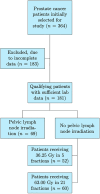Temporal dynamics of lymphocytes in prostate cancer patients treated with proton therapy
- PMID: 40308498
- PMCID: PMC12040820
- DOI: 10.3389/fonc.2025.1470876
Temporal dynamics of lymphocytes in prostate cancer patients treated with proton therapy
Abstract
Radiotherapy can be both immunosuppressive and immunostimulatory. Radiation-induced lymphopenia (RIL) is an ongoing challenge in cancer treatment. We investigated weekly changes in the absolute lymphocyte count (ALC) during proton radiotherapy, evaluating the effects of different dosage, fractionation schedules, and pelvic node irradiation (PNI). Prostate cancer patients were prospectively chosen for this study, due to their relatively homogenous treatment plans. Treatment protocols were categorized into three groups: Group A (n=52) received 36.25 Gy/5-fractions, Group B (n=60) underwent 63 Gy/21-fractions and group C (n=69) received 63 Gy/21-fractions plus PNI. To account for individual characteristic differences, a new categorization method was made, according to the change in ALC relative to the baseline. Lymphopenia (ALC < 1000 K/μL) developed in 8%, 17% and 84% of patients in groups A, B, and C, respectively. An initial increase in ALC occurred in 44%, 47% and 28% of groups A, B and C, respectively, and declined with proceeding fractions. Patients with PNI had the most pronounced reduction in their ALC relative to the baseline. Increased dosage and fractionation led to a higher incidence of lymphopenia. Understanding which factors influence ALC in particle therapy is vital for leveraging the immune-enhancing effects of radiotherapy, while minimising its immunosuppressive impacts.
Keywords: hypofractionation; immunostimulation; lymphopenia; prostate cancer; proton therapy; radiation oncology.
Copyright © 2025 Al-Hamami, Kurucz, Vondráček, Pekar, Andrlík, Dědečková, Benešová, Haas, Ondrová, Pasztorová, Vítek and Kubeš.
Conflict of interest statement
The authors declare that the research was conducted in the absence of any commercial or financial relationships that could be construed as a potential conflict of interest.
Figures






Similar articles
-
Late radiation-related lymphopenia after prostate stereotactic body radiation therapy plus or minus supplemental pelvic irradiation.Front Oncol. 2024 Nov 21;14:1459732. doi: 10.3389/fonc.2024.1459732. eCollection 2024. Front Oncol. 2024. PMID: 39640284 Free PMC article.
-
Patient-specific modeling of radiation-induced lymphopenia for head and neck cancer.Med Phys. 2025 Jun;52(6):3583-3594. doi: 10.1002/mp.17829. Epub 2025 Apr 14. Med Phys. 2025. PMID: 40229136
-
Pelvic bone marrow dose-volume predictors of late lymphopenia following pelvic lymph node radiation therapy for prostate cancer.Radiother Oncol. 2024 Jun;195:110230. doi: 10.1016/j.radonc.2024.110230. Epub 2024 Mar 17. Radiother Oncol. 2024. PMID: 38503355
-
Comprehensive Analysis of the Kinetics of Radiation-Induced Lymphocyte Loss in Patients Treated with External Beam Radiation Therapy.Radiat Res. 2020 Jan;193(1):73-81. doi: 10.1667/RR15367.1. Epub 2019 Nov 1. Radiat Res. 2020. PMID: 31675264
-
Normal Tissue Complication Probability Modeling of Severe Radiation-Induced Lymphopenia Using Blood Dose for Patients With Hepatocellular Carcinoma.Int J Radiat Oncol Biol Phys. 2024 Jul 1;119(3):1011-1020. doi: 10.1016/j.ijrobp.2023.11.060. Epub 2023 Dec 5. Int J Radiat Oncol Biol Phys. 2024. PMID: 38056776
References
-
- Damen PJJ, Kroese TE, van Hillegersberg R, Schuit E, Peters M, Verhoeff JJC, et al. . The influence of severe radiation-induced lymphopenia on overall survival in solid tumors: A systematic review and meta-analysis. Int J Radiat. Oncol Biol Phys. (2021) 111:936–48. doi: 10.1016/j.ijrobp.2021.07.1695 - DOI - PubMed
-
- Sini C, Fiorino C, Perna L, Noris Chiorda B, Deantoni CL, Bianchi M, et al. . Dose-volume effects for pelvic bone marrow in predicting hematological toxicity in prostate cancer radiotherapy with pelvic node irradiation. Radiother. Oncol. (2016) 118:79–84. doi: 10.1016/j.radonc.2015.11.020 - DOI - PubMed
LinkOut - more resources
Full Text Sources

